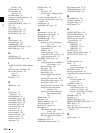
Appendixes
201
Glossary
certain types of noise inherent to
CCDs. See also CCD.
Hunting
Repeated brightening and darkening
of an image resulting from repeated
response to automatic iris control.
i.LINK
Another name for the IEEE1394-
1995 standards and their revisions.
XDCAM uses the i.LINK interface to
transfer DV streams by the AV/C
protocol, and to read and write
MPEG IMX and DVCAM data files
by FAM (File Access Mode).
Interlaced scan mode (CCD
output)
A scanning method in which odd
rows fields are read alternately with
even rows. (Odd-row fields and even-
row fields contain images from
different times.)
IRE scale
International Radio Engineers scale.
A scale of values that defines the
brightness level of a video signal.
The IRE is now the IEEE (Institute of
Electrical and Electronic Engineers).
Metadata
Information about the properties of
video and audio content. XDCAM
records metadata such as UMIDs and
essence marks, and the supplied
PDZ-1 Proxy Browsing Software
PDZ-1 can be used to record
information such as titles and
comments.
MXF
Material eXchange Format. A file
exchange format developed by the
Pro-MPEG Forum. Equipment from
different manufacturers can
exchange files in this format.
ND filter
Neutral Density filter. ND filters
reduce the amount of incident light
equally across the entire visible
wavelength range without affecting
color.
Non-audio
General term for audio signals other
than linear PCM, such as Dolby E
and Dolby Digital (AC-3).
1)
XDCAM can record non-audio as an
input signal.
1) Dolby is a trademark of Dolby Laboratories.
Non-drop frame mode
A mode of advancing time code
which ignores the difference in frame
values between real time and the time
code. Using this mode produces a
difference of approximately 86
seconds per day between real time
and time code, which causes
problems when editing programs in
units of seconds using the number of
frames as a reference.
Progressive scan mode (CCD
output)
A scanning method in which odd
rows and even rows are read at the
same time. Also called full-screen
scanning.
Proxy AV data
Low-resolution data with a video
bandwidth of 1.5 Mbps and an audio
bandwidth of 64 Kbps per channel.
This unit records proxy AV data
automatically whenever high-
resolution MPEG IMX or DVCAM
data is recorded.
Reference video signal
A video signal that contains a sync
signal or sync and burst signals, used
as a reference for synchronization of
video equipment.
Return video
A video signal returned to a camera
from a VTR, or a video signal
selected from among several camera
angles in a control room and returned
to a camera so the cameraman can
check the video.
SDI
Serial Digital Interface. An interface
standardized as SMPTE 259M which
enables the transmission of an
uncompressed digital component
stream.
Shot data
Data recorded, while shooting, in the
color bars, the user bits data of VITC,
and so forth. Includes the model
name, serial number, date, time, shot
number, and ID1 to ID4.
Shutter speed
The time that the shutter is open.
Slow shutter speeds give bright
images, but motion resolution is
lower.
SMPTE
Society of Motion Picture and
Television Engineers, a professional
association established in the U.S.A.
mainly for the purpose of setting
forth motion picture and television
engineering standards.
S/N
Signal-to-Noise ratio. The relation of
the strength of the desired signal to
the accompanying electronic
interference, the noise. If S/N is high,
sounds are reproduced with less noise
and pictures are reproduced clearly
without snow.
SNMP
Simple Network Management
Protocol. XDCAM uses this protocol
to monitor equipment operating
status via network connectors.
Sub clip
One of the sections which make up a
clip list. A sub clip may be part of a
clip or an entire clip.
Thumbnail image
A reduced still picture of video for
display on a GUI screen. XDCAM
creates thumbnail images from proxy
video, and displays them as index
pictures on GUI screens.
Time code
A digitally encoded signal which is
recorded with video data to identify
each frame of the video by hour,
minute, second and frame number.
SMPTE time code is applied to
NTSC system, and EBU time code to
PAL and SECAM systems.
Time code synchronization
To synchronize the built-in time code
generator of video equipment to an
external time code.
Turbo gain
Video amplifier gain increased from
30 dB by 6 to 18 dB by combining
adjacent pixels of the CCD.


















